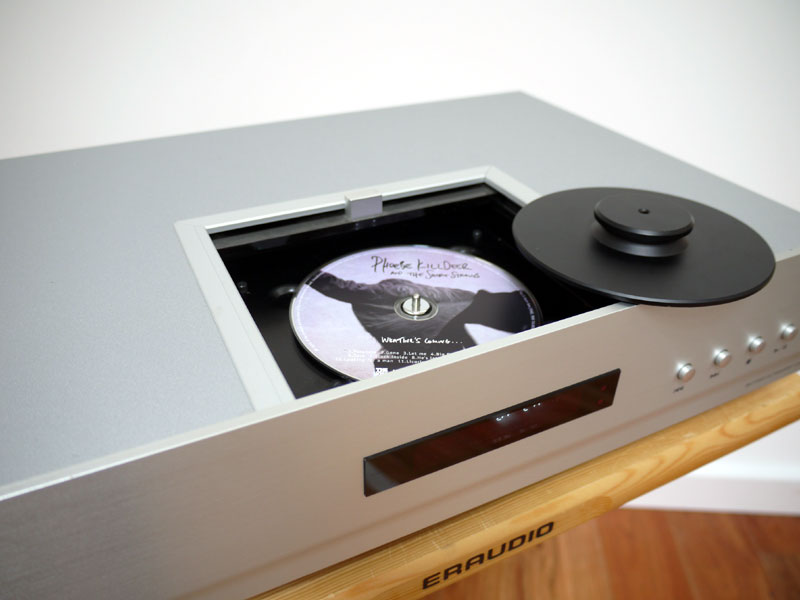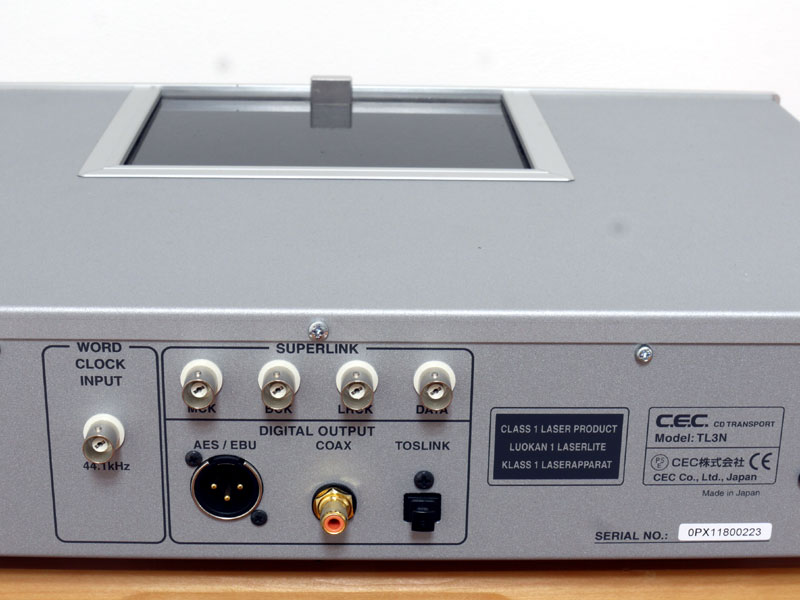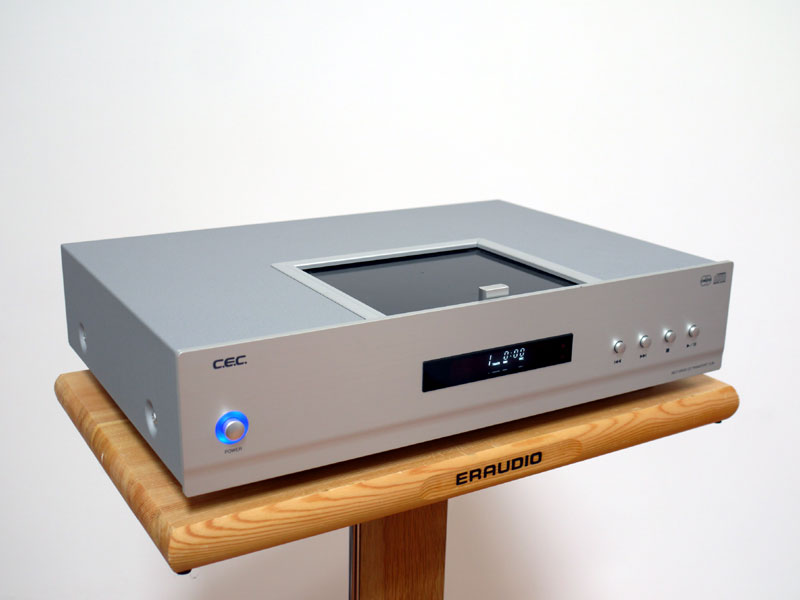A Transport of Delight: CEC's TL 3N
or whatever reason, I’ve always found top-loading CD transports appealing. From my all-time favorites (at least as far as looks are concerned), the original Micromegas with their lids formed from sculpted, hinged slabs of Perspex, to the Zanden players with their cookie-jar covers, many of the players I’ve lusted after have featured manual loading in the vertical plane. With the increased emphasis on (and understanding of) the importance of internal mechanical grounding and the crucial part it plays in the performance of audio electronics, that preference finally has some sort of explanation to go with it, but even without that logical prop, top-loaders just seem to be somehow right. Okay, it may just be an extension of embedded expectation; every drawer-loading record player I’ve ever heard sounded less than great, but then there are sound engineering reasons for that, and reading a CD really isn’t that different from reading a vinyl disc -- at least in mechanical terms. The distortion mechanisms might differ, but they’re just as audible, so much so that the expensive Esoteric transports (used by dCS amongst others) go to enormous lengths to add a drawer-loading function to what is in essence a mechanically grounded mechanism. With the tsunami of computer audio and file replay sweeping down upon an audio industry that sits quaking jelly-like in its path, this observation might seem to be of little more than passing, academic interest, but I would beg to differ. Not so long ago, the DAC was pretty much as dead as the dodo, reduced to a couple of breeding pairs, eking out a miserable existence in dubious captivity, surrounded by herds of free-range, high-performance, high-value single-box disc players. My, how the mighty have fallen! Whilst certain sectors of the market seem intent on an undignified scramble to produce the cheapest possible USB replay solution, quality DACs have enjoyed a sudden resurgence in sales -- assuming they have the all-important USB input (and if they haven’t it’s remarkable how quickly one will appear). Meanwhile, you can’t give away an all-singing, all-dancing CD player unless it too has endured the indignity of having a USB input attached to its backside and it’s designation changed to suggest that it’s actually a DAC with an internal transport -- and even then, as often as not, the purchaser will opt for a dedicated DAC instead. But the rise of the DAC has in turn opened the door to specialist transports. There’s an old adage that if your CD player sounds better than your turntable, then you need to take a long, hard look at your turntable. To some extent the same can be said of CD replay and computer audio. If your music sounds better off of your laptop, then the parlous quality of available CD transport mechanisms is at least in part to blame. But the shift to DAC-based digital replay has revealed that, in practice, while you need a transport of some description, if only to rip discs to your hard drive, replaying even the lowly Red Book CD on a "decent transport" (whisper it quietly) will easily give a ripped copy of the same disc rather more than a run for its money. There’s no escaping the fact that disc replay done right possesses certain musical qualities that file replay still struggles to match.
Which brings us to CEC’s TL 3N CD transport -- a basic (and I do mean basic) top-loading disc spinner. A remarkably bland, flat-faced, medium-profile unit built into a simple bent-metal box, it has a front fascia with a narrow LED display and four buttons that cover the transport functions. Sunk into the top surface is a (manual) sliding hatch that gives access to the transport, hiding below a heavy, full-width disc clamp. The sort of multi-button generic handset you get with a $150 Blu-ray player offers additional functionality, some of which (the myriad input options) are obviously redundant. So far, not much to get excited about. It’s not even that much heavier than it looks. In fact, if it hadn’t arrived tucked under the arm of the irrepressible Kevin Scott from Definitive Audio, a man who knows a thing or two about unearthing good sound from unlikely sources, I doubt I’d have given it a second glance. With a few months of experience under my belt, I’m now extremely glad that I did.
The first clue to the fact that this is no ordinary transport comes from the back panel. As well as the more or less standard AES/EBU XLR, S/PDIF (sadly on RCA rather than BNC) and TosLink optical connectors, there are two other features that should give you pause for thought. The first is a separate BNC input for an external word clock. The second is a bank of four BNCs dedicated to CEC’s own Superlink connection protocol, a setup that separates clock and data streams but which, sadly, can only be used with an equivalently equipped CEC DAC (or one from B.M.C.; see Marc Mickelson's B.MC. review for details). Clearly, these guys take data integrity seriously. But it’s under the hood that things get seriously interesting. The TL 3N employs CEC’s twin-motor belt-driven CD transport. Like the high-priced and highly regarded Burmester 001 and 089 players, which employ in-house-modified Philips mechs, this CEC dispenses with the standard direct-drive motor as used by the majority of transports, opting instead for something that would look more at home on an analog rig. CEC’s transport is a thing of simple beauty. The disc spindle and laser sled are mounted on a thick alloy subchassis, raised on four soft polymer sprung isolators. The two motors, one to spin the disc, the other to drive the sled, are rigidly mounted to the substantial baseplate, with belts connecting their spindles to the transport proper, thus creating a genuine belt-and-braces isolation system. Not only does this protect the transport and its delicate data stream from the deleterious intrusion of vibration generated by the motors, the substantial baseplate and rigid mounting that results allow energy to sink effectively into the chassis and then into the supporting surface, if you take the trouble to bypass the TL 3N’s rubber feet. CEC have been building and refining their belt-driven CD transport mechanism for over 20 years, and while the iteration employed in this, their most affordable unit, is the most basic version, almost by definition it has gotten the basics right. But the best bit is yet to come. The TL 3N costs a relatively approachable £2400, not exactly pocket change, but an awful lot less than the various other belt-driven CD players and transports I’ve come across, notably the aforementioned Burmesters. Okay, you don’t get the fancy chromework or reflected glory of the Burmester brand name, but you do get a transport that showed both the dCS Paganini and the transport section of the Wadia S7i a pretty clean pair of heals! Even a swift listen will demonstrate just how solid and dimensional this transport sounds. It brings a rooted and purposeful quality to music, coupled to a clearly defined and stable soundstage. Listen longer and you’ll discover that the sense of stable presence and acoustic space stems from an internal order, a sense of pace and place that brings not just spatial organization to the musical performance, but a rhythmic integrity and sinuous fluidity to proceedings that manifests itself in far more intimate and expressive, dynamic and dramatic range as each performer or performance demands. It brings an uncomplicated directness to musical communication that makes it far easier to appreciate not just what is happening but why -- and the less effort you need to put into decoding the audio signal, the more you are going to enjoy it. Play something delicate and intimate and the TL 3N is all grace and poise, restraint and deft nuance. But load up something with pace, drive and attack and you’d better be holding onto your hat. The CEC requires only the smallest of musical encouragement to launch itself (and you) down an emotional toboggan ride, an avalanche of sheer musical energy and momentum. But the beauty is the way it reaches the bottom of the run, breathing deeply and red of cheek, but still perfectly under control. This is one impressive and musically sure-footed performer. As that suggests, sonically (but more importantly, musically) the impact of the CEC is far from subtle. As an example I’ll wheel out the original Phoebe Killdeer album, Phoebe Killdeer & the Short Straws' Weather’s Coming [PIAS 733.0014.022], but pretty much anything will do. These are differences that don’t favor one genre over another; and as you’d expect from a member of Nouvelle Vague, the tracks on Weather’s Coming are hard to classify, with their mix of rhythmic complexity, inventive instrumentation and vocal variation. Compare the CEC, playing through the Wadia S7i’s AES/EBU input, to the Wadia’s own internal transport (itself no slouch) and right from the off the added depth, weight, solidity and musical purpose generated by the belt-drive transport are smack-you-in-the-face obvious. The CEC gives that opening drum beat more weight and texture, depth and power, but it also brings the necessary insistent quality that pulls in the listener while simultaneously driving the track. As the layers build, it’s the CEC that maintains their separation and broad tonal palette, so that when the Wadia glazes over and gets congested in the chorus, the TL 3N keeps things spacious, textured and moving forward. This ability to maintain both the spatial and tonal distinction between instruments while also effortlessly maintaining the music’s motion and pattern are what set the CEC so far ahead of the other transports that I customarily use -- units that are already ahead of the crowd in this respect. But the CEC is simply in another league. Click through to track 8, "He’s Late," and you’ll see exactly what I mean. It opens with a carefully constructed soundscape, with the sound of rain and a tolling bell to offset the widely spaced and sparse instrumentation. With the Wadia the effect is certainly interesting and beautifully arranged; with the CEC it is genuinely atmospheric. The hollow patter of the rain and the sound of the wind are more natural, the thunder and the tolling bell more distant, heavy with foreboding. They set up this song of waiting for bad news, so that when the vocals start the subject seems utterly natural, as natural as the beautifully expressive and focused voice itself.
In some ways it is ironic that the CEC transport should deliver so emphatically in exactly the areas that CD has traditionally been weakest, just when the format itself is passing into irrelevance -- at least as far as many listeners and commentators would have you believe (though not us here at The Audio Beat). While the simple casework and manual operation of the TL 3N hardly reek of high-end niceties, the price doesn’t either, and in many ways that’s the most interesting thing of all. The combination of a Jeff Rowland Aeris DAC and the CEC transport will deliver Red Book performance to challenge anything available from digital sources these days. It may not be the best, but it’s not far behind, while the combined cost in the UK barely breaks the £10,000 barrier. Yes, products like the Wadax Pre 1, the Neodio Origine and the dCS Vivaldi stack will all better the CEC/Rowland pairing in one way or another, but at a significant price. Meanwhile the CEC/Rowland setup will sit happily at the same table as those more illustrious alternatives, less than a third of the price of the next-most-affordable option, while giving away little if anything in terms of flexibility or versatility. The Aeris will still switch multiple digital inputs, still accept high-res files via USB (albeit not at the highest possible bit rates) and it still makes a better fist than most when it comes to driving a power amp directly. Okay, so the transport demands a top-shelf placement, but that seems a small price to pay. In short, the pairing gives little away in practical terms while delivering remarkable performance from silver disc -- the sort of performance that highlights the ongoing issues with the musical integrity of file-replay systems, issues that still demand considerable attention. I’m sure that those problems can and in all probability will be solved, but the history of audio development suggests that might be a while coming, with digital development constantly impeded and slowed by the Greek chorus that constantly tells us that it’s already perfect! CEC offer two other belt-driven CD transports both based on essentially the same mechanism, just beefed up and reworked to suit the different chassis arrangements: the TL 1N is priced at £8000, while the TL 0X costs £16,000 but does feature a massive subchassis, sophisticated sprung suspension and much better motors. It also offers the sort of brutal aesthetic and angular, stacked-up, multi-facetted construction that reminds me of those multi-turreted "land ships" the Russians built between the two world wars, but I’ll admit to casting covetous glances at the sleeker lines offered by the TL N1. But, pretty as it is, can basically the same mechanical elements in a more massive chassis deliver sonic improvements to justify a three-times hike in the price? In that one question lies the essential beauty of the TL
3N. It delivers so much performance for such a modest investment -- so much performance,
in fact, that I can see more than a few customers buying it simply to rip their discs,
only to rediscover just how good they themselves can sound. |



